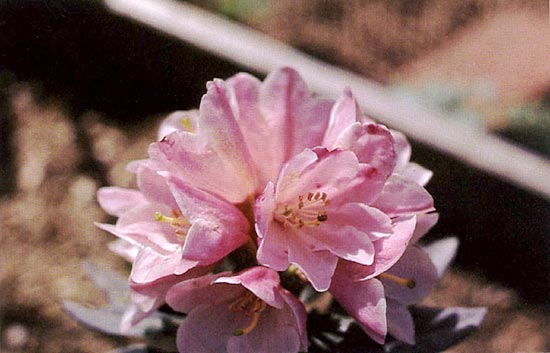Rhododendron pachysanthum, Hayata
John Patrick, El Sobrante, California

|
|
R. pachysanthum
Photo by Bill Moyles |
Erroneously reported by the author in this journal (ARS Quarterly Bulletin Vol. 29 No. 1) as a new species with the proposed name "venturi",
R. pachysanthum
has now flowered in cultivation; to our knowledge for the first time.
Specimens and seed were collected several times from 1969 onwards through 1974. As no descriptions were found in readily available literature, it was assumed that a hitherto un-described species had made its appearance, as no herbarium specimens were found in the herbarium of Taiwan University at that time. In 1975, the long neglected herbarium was renovated and specimens from two localities were unearthed. All specimens bore the legend,
R. pachysanthum
.
Upon further investigation at the herbarium of Tokyo University, the type specimen was located. The herbarium library at Tokyo University revealed that
R. pachysanthum
had been described in Hayata's monumental work
Icones Plantarum Formosanum
, in 1915, both in English and Latin. For some unknown reason, this excellent work had been ignored in succeeding literature. To further compound this omission, the authors of
The Species Rhododendron
as well as the authors of
The Rhododendron Handbook
part One, have chosen to classify
R. pachysanthum
as a pseudonym of
R. morii
, obviously without benefit of herbarium material nor thoroughly researching available literature; i.e., (cones Plantarum Formosanum, which was available at Edinburgh and at Tokyo University.
To further compound the initial confusion created inadvertently by the author, the Japanese publication;
Azaleas & Rhododendron
; Kodansha. p54 Plate 29, published the name "R. venturi" without quotes; this, unknown to the author prior to publication, as "venturi" was only a proposed name, having no validity.
Additional confusion has been injected into
R. pachysanthum
by offerings of seed from Taiwan by a private source who identified it as "
R. nankotaisanense
". This seed has been distributed in Japan and in The United States. The validity of "
R. nankotaisanense
" was challenged by Wilson as being a form of
R. morii
, which it certainly is, the author having been through the population personally in December 1974.
In conclusion:
R. pachysanthum
Hayata is a valid species and all field notes, references and descriptions are valid with the exception of the erroneously proposed name "venturi" which never had status.